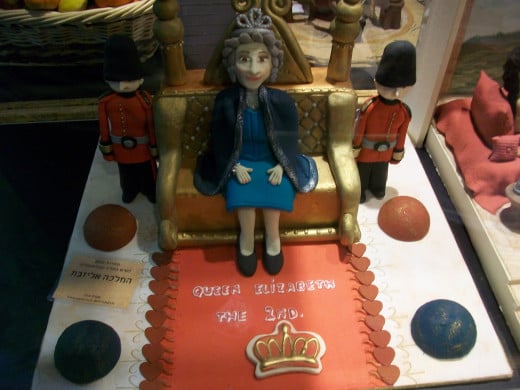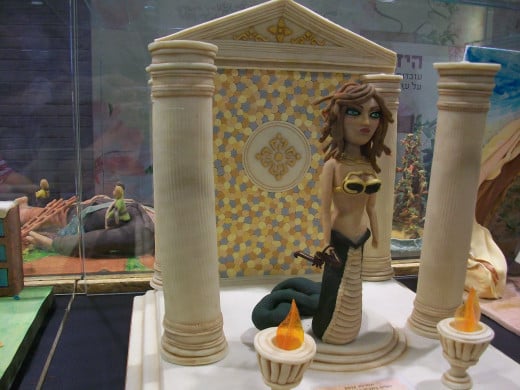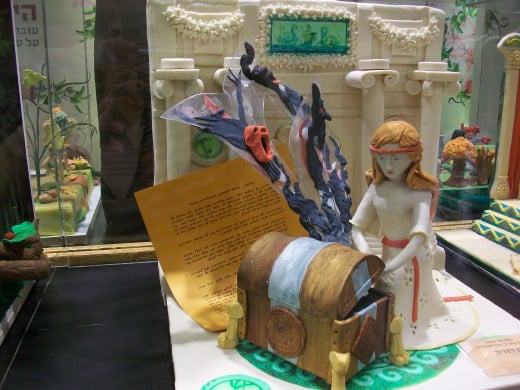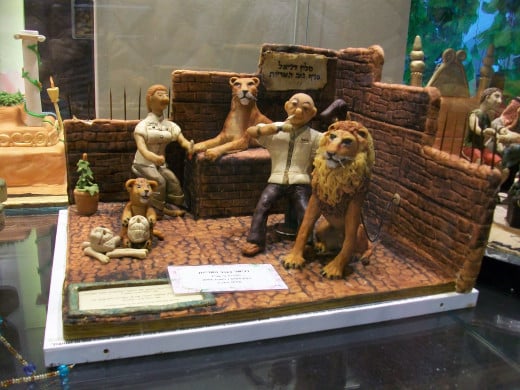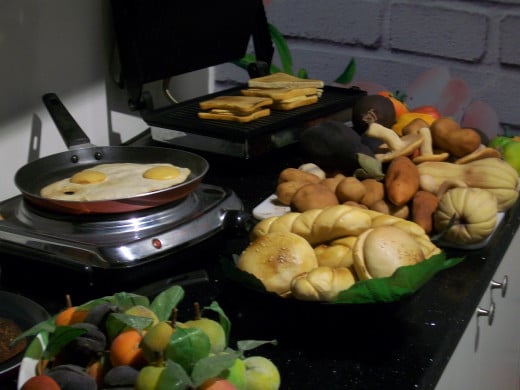The Marzipan Museum in Kfar Tavor, Israel
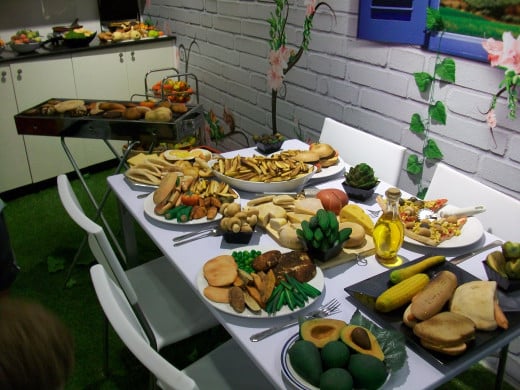
On a recent trip to visit family in Israel, we found ourselves with a car, three children (the extra one being an Israeli cousin), and a long, empty day in front of us. The consensus around the neighborhood was that we should go to the Marzipan Museum, about 60 mountainous kilometers away from where we were staying. I was dubious; sure, marzipan is delicious, but what could there be in a museum dedicated to it? In the end, I agreed to the hour's drive, since the village we were staying in was too small to even have a grocery store of its own, let alone any tourist attractions. And do you know what? Though small, the museum was totally worth it!
The Marzipan (or Martsipan) Museum
Kfar Tavor is a picturesque town situated in the Lower Galilee region, in the shadow of Mount Tabor (called in Hebrew Har Tavor). At the western edge of town is a small tourist complex built of the ubiquitous local limestone and covered in grapevines, which houses the Marzipan (or Martsipan, as they pronounce it) Museum, along with a small winery and an upscale (but non-kosher) restaurant. (This restaurant is the only one in town, by the way, so if you're traveling with small children you may want to bring along snacks to eat in the beautiful, shady courtyard instead.)
The Museum itself is fairly small; it comprises a large room of marzipan exhibits, windows that peek into the factory, a movie-viewing room, two large workshop rooms for practical demonstrations, and a store. You have several admission options; we chose to view the exhibits and do the marzipan workshop, which cost us about nine dollars apiece. A chocolate workshop is an additional two dollars or so; seeing the exhibits only is about four dollars, but I don't think that's worth it, since you would be finished in half an hour.





The Marzipan Exhibits
You walk through an enchanted garden door (think curtain made of fake ivy) to enter into a room showcasing all sorts of scenes made entirely of marzipan. These scenes varied greatly in quality, and we were made to understand (via the docent's stilted English and my husband's pidgin Hebrew) that they were mostly entries into an annual marzipan contest. We declined the docent's offer to show us around, preferring to examine the exhibits on our own and take our chances at understanding (or not) the explanation cards.
The kids had a great time pointing out several naked ladies fashioned from marzipan (secular Israeli society has a more European attitude to nudity than we prudish Americans do, so that got lots of giggles). There were several elaborate Marie Antoinettes, scenes from various fairy tales and myths, and a beautifully done Coco Chanel. There was also a permanent exhibit of food made completely from marzipan, including corn on the cob, hamburgers, avocados, grilled cheese, and sunny-side-up eggs. Around the outer walls were glass cases showing how marzipan can be shaped into animals and other shapes.
Although some of the exhibits did not show tremendous technical skill, we still marveled at every scene, "That can't possibly be made of marzipan!" but it was, every time.
The Marzipan Museum's Movie
In a viewing room just off the main part of the museum you can watch a hilariously offensive video about the history and art of marzipan in Hebrew or English. It was offensive because the narrator is dressed as the Israeli version of a Sopranos-style gangster, complete with ill-fitting dark suit and cigar; hilarious because seriously, have you ever heard Hebrew spoken with a fake Italian accent?
In a showcase on the wall of the viewing room were several heads of (presumably famous) people made of (what else?) marzipan. The only one I recognized was Ben-Gurion, so either my knowledge of Israeli history leaves something to be desired, or the skill of the artist does. (Frankly, it's probably a combination of the two.)
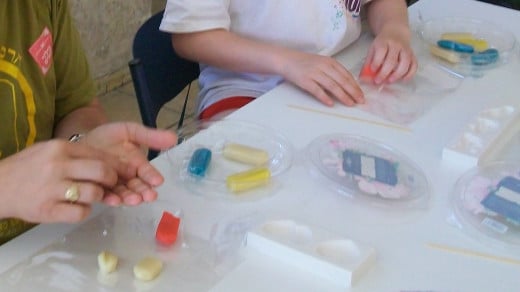
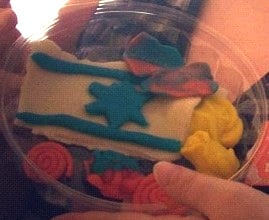
The Hands-On Marzipan Workshop
After we finished the movie, we were each given five small logs of marzipan and some tools to play around with. The docent once again offered to help us and show us some techniques, but being well experienced with Play-doh, we figured we could handle it ourselves. We mixed colors, rolled, patted, cut, and shaped to our hearts' delight. The tools they gave us included cookie cutters, soft silicone molds, pointed sticks, and a texture plate. Our creations included snakes, hearts, flowers (from the mold), and an Israeli flag, but we were limited only by our imaginations. A school group there at the same time was receiving detailed instruction in making fruit and vegetable shapes, but we had more fun doing it on our own!
Buying Marzipan and Chocolate
You can buy all sorts of almond-based and chocolate items at the museum's store, handmade in their own factory. I bought a marzipan challah because I thought it was quite clever, but they also had traditional fruit shapes, animals, and blocks of plain marzipan for DIY-ers. My kids loved the "energy bars" made from almond paste and cranberries. The chocolate offerings included different types of nuts and dried fruit dipped in dark, milk, and white chocolate. The most intriguing products were a wall of liqueurs in flavors I had never before seen, such as kiwi and passionfruit. Unfortunately, our suitcases were already too heavy, so we didn't bring home any of those to sample!
One Thing You Can Do With Marzipan
If You Can't Make it to Israel, Play With Marzipan in Your Own Home!
Marzipan is so much fun to play with, my son kept calling it "edible model magic." You don't want to miss out on the experience just because you don't have the dough for a 12-hour plane ride! Buy some marzipan and simple tools, and get started creating. Soon you'll be good enough to make a museum of your very own.
You may be able to find marzipan in tubs or tubes in the baking section of your supermarket, but if not you can buy it in bulk online. Floppy silicone molds allow you to make intricate shapes easily. (Make sure you get soft molds, because it will not pop out of hard molds easily.) Use everyday kitchen accessories like a rolling pin, sharp knife, cookie cutters, and toothpicks (to hold bodies together or etch thin lines) to help make your creations. If you have kids, you probably have some Play-doh playsets around the house; wash the extruder and its accessories thoroughly (run them through the dishwasher after picking off any dried crud) and use them to create strands of hair, spaghetti, stars, tubes, or dozens of other possibilities. Be creative and have fun!
The Marzipan Museum is located on the western edge of the town, around the corner from the cemetary.
Make Your Own Marzipan Designs!

